TOP 5 Android Trends to Watch in 2018
On the journey from Cupcake to Oreo, Android has had a transformation over the years. With each new version of the software, what’s ‘en vogue’ keeps on changing and many Android trends have come and gone since the software’s inception.
Android is the most used smartphone OS, so new Android trends can impact not just Android development, but the app development scenario across the entire world. This, the general proliferation of smartphones, and the mobile-first approach of the people all mean that it is important for us developers to be up to date with those trends.
Without further ado then, let’s take a look at the Android trends for 2018!
1 – Android VR & AR
We might be combining two Android trends into one here, but Android VR & AR has been a big hit over the last 2 years – especially in the gaming industry. Last year Google launched Daydream (a mobile virtual reality platform) and Samsung has had its own Gear VR since late 2015 – a platform which was designed to work with Samsung’s flagship smartphones.
VR replaces your current environment with a completely new virtual environment, where AR adds on to the current environment. No doubt VR and AR have a lot of possibilities, and increased uptake from developers will no doubt lead to some amazing new apps. In the near future, we’re sure to see the lines between reality, VR and AR blurring even more as well.
2 – Kotlin
Kotlin is a relatively new programming language. As it is similar to Java and is based on JVM, moving from Java to Kotlin is easy – which might be why it’s one of this year’s Android trends. Kotlin was announced as an official programming language for Android by Google in Google IO 2017 and since then, it has been taken up by Android developers quite well.
Some of the benefits of Kotlin are:
- Null safety
- Kotlin extensions
- Lambda
- Data classes
Kotlin is fully supported in Android Studio 3.0. It also works alongside Java really well when used in the same project. Therefore, it is safe to start coding in Kotlin for existing projects too. Most of us have already started using Kotlin in our projects, and since it’s one of the hot Android trends right now, it is expected that even more developers will pick it up this year.
3 – Internet of things
Around a year ago, Google announced Android Things and stepped into the IoT market.
Android Things OS is based on a cut down version of Android. Due to Android’s huge penetration in the market and cheap devices, it is the first choice when it comes to IoT.
The OS is designed to run on embedded systems built on a single circuit board like Raspberry Pi, and others like it.
Android Developers are leading the charge in IoT development and they should aim to skill up in their hardware knowledge to really master IoT.
4 – Machine learning
Yes, Machine learning can help solve problems that conventional apps cannot. Therefore it has been one of the biggest Android trends of 2017, and it is expected to be the same this year too.
We have seen driverless cars, face recognition apps and even chatbots which are based on Machine Learning.
Until now, ML has been confined mostly to the cloud. There are many ML cloud services available which result in the return of raw data. Having this capability offline will introduce a whole new set of possibilities.
5 – Material design
Material design isn’t a new concept but most of us will agree that this is one of the most important mobile design trends for 2018 – which also means that it’s one of the key Android trends for 2018. Just like Android trends, design trends change very often and therefore it is again necessary for developers to keep up with them.
This is a good place to start with Material Design.
Most of the apps being built nowadays are based on Material design. The time for Flat design is now over and there are still apps that need design upgrades – so hopefully, we will see some amazing updates this year.
Mooncascade
Mooncascade is a product development company focused on building new disruptive solutions with real business and market impact. With a team of nearly 60 specialists, we are the chosen product development partner for the region’s telecommunication companies, we work closely with financial companies, and are often brought in when large industries require an agile and experienced product development partner.

